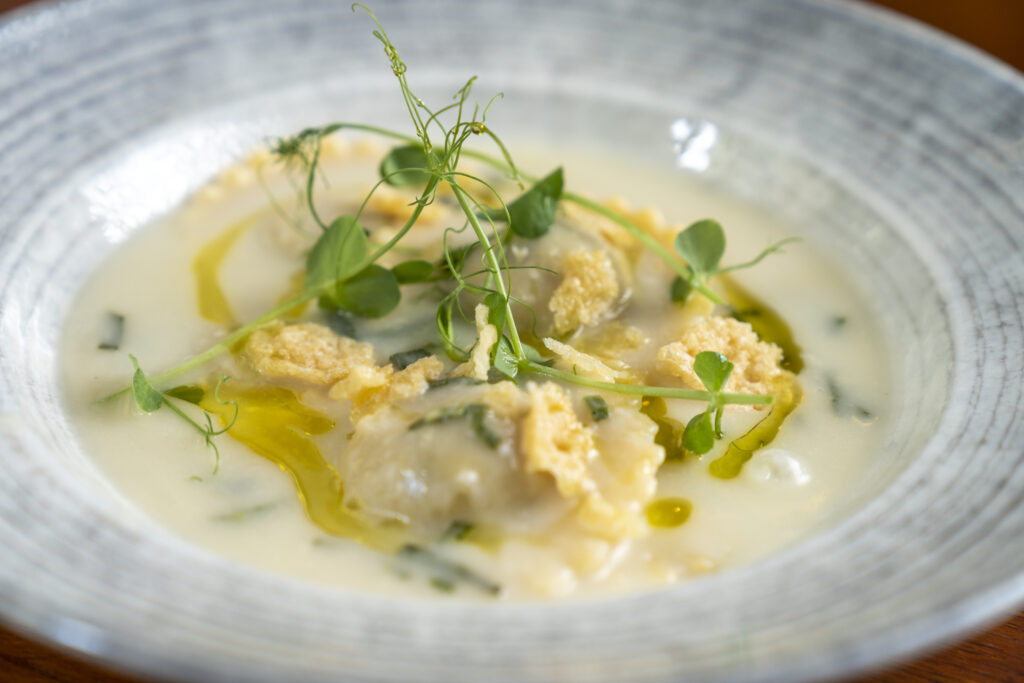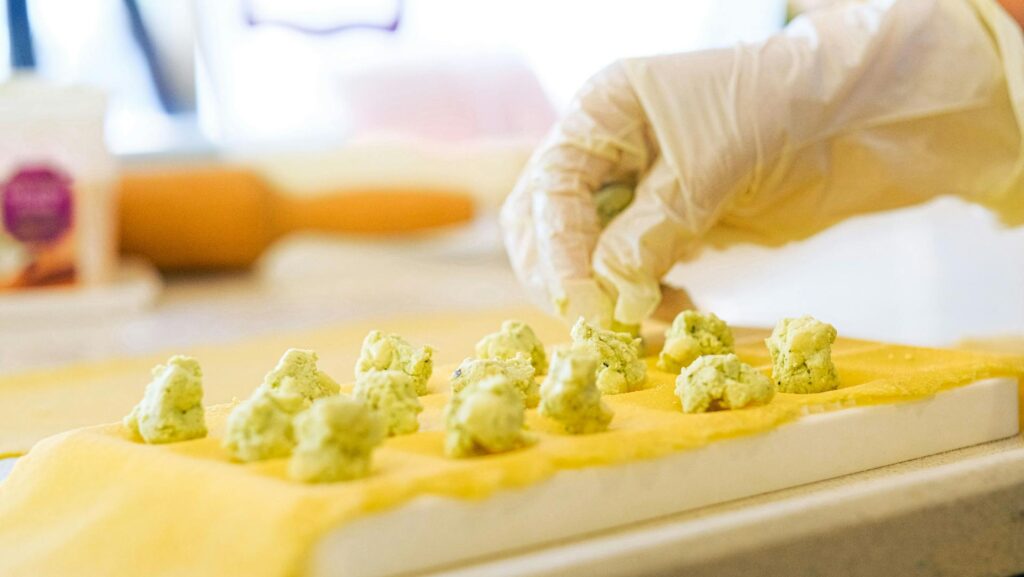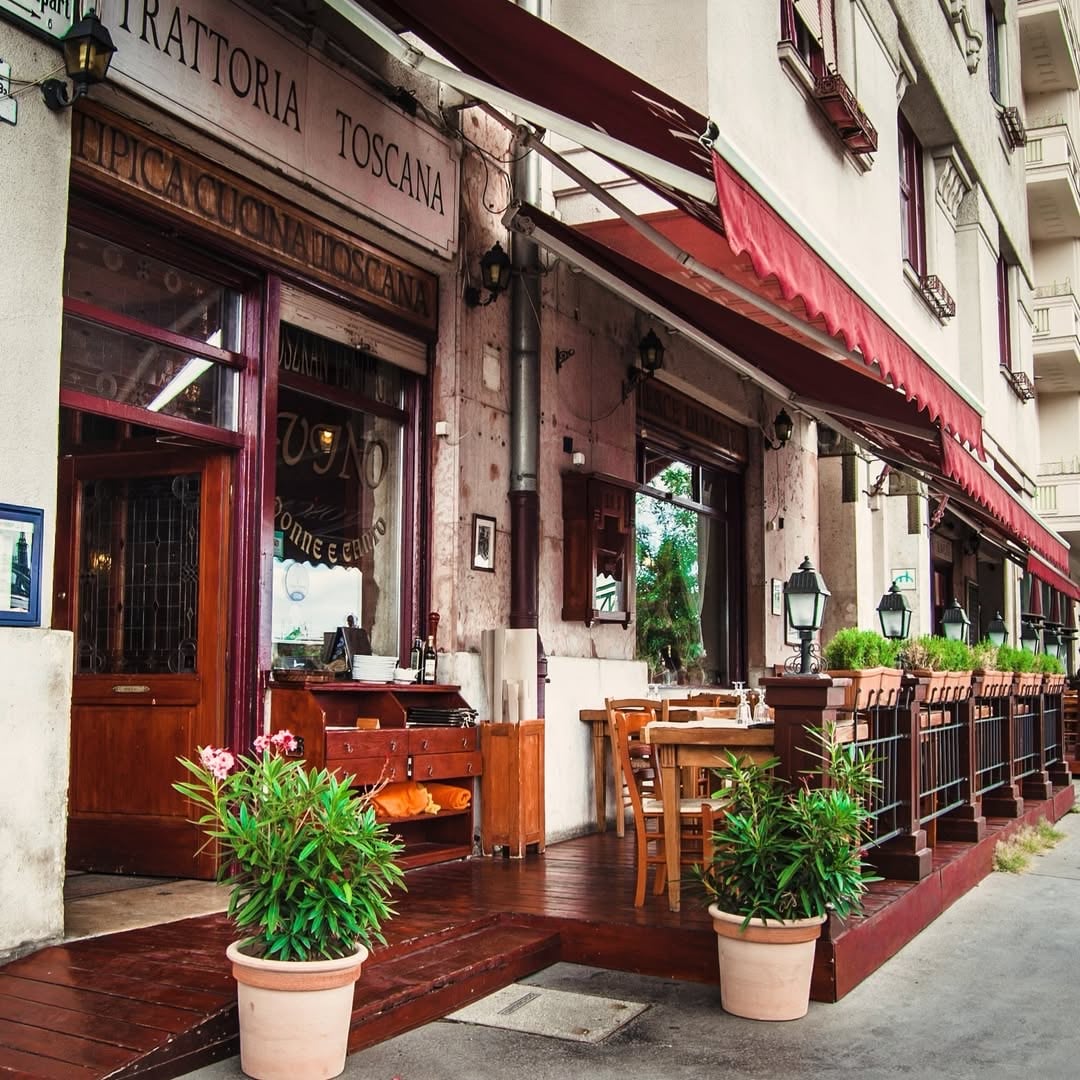The special charm of Italian cuisine lies in its ability to create magical flavors from the simplest of ingredients. One of the most beautiful examples of this is ravioli: a true dream dish for lovers of stuffed pasta, always able to offer new and intriguing surprises. ravioli: Whether prepared with creamy cheese and fresh vegetables or with a rich, hearty meat filling, ravioli always brings a festive atmosphere to the family table or to a cozy dinner. Ravioli is not only an iconic dish of traditional Italian cuisine, but also a symbol of homeliness, creativity, and hospitality.
Now, we’ll reveal what to use when making it, what the perfect ravioli dough recipe is, where ravioli originates from, and what makes Trattoria Toscana’s foie gras ravioli so special.
What is ravioli? Characteristics, types, and fillings
Ravioli is the best-known and most diverse type of Italian stuffed pasta, with countless variations to discover. Its base is a simple yet high-quality dough—flour, eggs, and a pinch of salt—rolled out thin and cut into little pillow-like parcels filled with savory or mild fillings. A good ravioli dough is springy and silky, while the filling can be richly seasoned and full-flavored—be it meaty, vegetable-based, cheesy, or featuring a special festive combination such as foie gras or dried fruit.
The true magic of ravioli lies in its endless variety: depending on the region, the fillings, shapes (square, round, or crescent), and even the sauces served with it can differ. One of the most popular versions is cheese and spinach, but pumpkin, mushroom, and classic meat fillings are also beloved. The authentic Italian ravioli dough recipe puts great emphasis on fresh, natural ingredients, as these truly give soul to the dish.

Simple, authentic Italian ravioli dough recipe & filling suggestion
Many people think that making homemade ravioli is only for professionals, but in reality, with a few basic ingredients, a bit of manual skill, and a good recipe, anyone can create an enchanting Italian dish at home. Here is how to prepare the authentic Italian ravioli dough, along with a classic cheese and spinach filling—but of course, feel free to try your own variations!
Ravioli dough recipe (basic):
Ingredients (serves approx. 3-4):
- 300 g 00 or BL55 fine flour
- 3 medium eggs
- a pinch of salt
Preparation:
- Sprinkle the flour onto a kneading board and make a well in the center. Crack the eggs into the well and add a pinch of salt.
- Combine the ingredients first with a fork, then with your hands, and knead into a smooth, elastic dough (about 8–10 minutes). If the dough feels too hard, add a few drops of water.
- Wrap the dough in plastic wrap and let it rest for at least 30 minutes.
- Next, roll out the dough into a thin sheet—ideally with a pasta machine, but a rolling pin will work as well.
Classic ravioli filling (spinach and ricotta):
Ingredients:
- 200 g ricotta cheese
- 100 g fresh spinach (or 80 g frozen, thawed)
- 1 egg yolk
- 30 g grated Parmesan
- salt, pepper, freshly grated nutmeg
Preparation:
- Sauté the spinach in a little butter until wilted, then chop it finely and squeeze out the excess liquid. Mix it with the ricotta, egg yolk, Parmesan, salt, pepper, and nutmeg.
Shaping and cooking the ravioli:
- Divide the dough in half and roll out two large sheets. Place small amounts (about half a teaspoon) of filling on one sheet, spacing them 3–4 cm apart.
- Cover with the other sheet of dough and press around the filling to seal, making sure no air is trapped inside.
- Cut into 4 x 4 cm squares with a pastry cutter or knife, and seal the edges with your fingertips.
- Cook the ravioli in gently boiling, lightly salted water for 2–3 minutes, until they rise to the surface.
Serving tip:
Ravioli served with sage leaves sautéed in butter and freshly grated Parmesan is a classic that can’t go wrong. Try it with mushroom, pumpkin, or even meat fillings!

Origin, history, interesting background information
The origins of ravioli date back to the Middle Ages, when Italian housewives, out of practicality and creativity, would use freshly made pasta to wrap leftovers. The name itself almost certainly comes from the Italian verb “riavvolgere” (to wrap, to cover), as the essence of ravioli lies in its delicate filling being enclosed and protected by a layer of pasta.
Ravioli was first mentioned in writing in the Liguria region in the 14th century, but it soon spread throughout Italy, with everyone adding their own family flavors and traditions. In the north and in Tuscany you’ll typically find cheese and spinach, sage and butter, or even meat fillings, while in the east and south, ravioli is often made for festive occasions with richer fillings—sometimes with dried fruits, nuts, or fresh herbs.
Over the decades, ravioli has become one of the icons of Italian gastronomy, earning its place on every festive table, but also becoming an everyday favorite thanks to its speed and versatility. No two ravioli are ever exactly the same: each household prepares it a little differently, so every bite contains the taste of home, the centuries-old experience of mothers and grandmothers, and the richness of local traditions.
In Italy, ravioli is also associated with certain holidays: it is often served during Carnival or Easter, and in many regions it is traditional to prepare a sweet chestnut and raisin filling for All Souls’ Day. So ravioli is not just a dish, but a living tradition that connects generations and brings families together.
Ravioli at Trattoria Toscana – Foie gras ravioli with dried plums and sage butter
The philosophy of the Trattoria Toscana kitchen is rooted in memorable, high-quality flavors, respect for tradition, and creative innovation. This is the spirit in which one of our signature dishes was born: foie gras ravioli with dried plums and sage butter—a unique and elegant combination that is both classic and special.
With us, ravioli is always made fresh from homemade pasta dough, with real attention to detail. The dough is always rolled thin to elegantly wrap the rich, delicate foie gras filling. The sweet, smoky aroma of dried plums perfectly complements the richness of the foie gras, while the buttery sage sauce harmoniously highlights and enhances the complexity of the flavors.
Shaping the ravioli is truly a ritual for us; each little pillow is made by hand, with individual care, to achieve the perfect balance between the silky filling and the fresh pasta. After cooking the homemade ravioli, we don’t hide this delicacy in a complicated, heavy sauce—instead, we gently toss it in golden, fragrant butter with fresh sage leaves, just enough to let every layer of flavor shine through.
Our foie gras ravioli is truly our signature dish, making it a perfect choice for a festive dinner or a special weekday evening.

Recommendation
Ravioli is more than just a simple pasta dish: it is a creation where the traditions of Italian cuisine meet creativity. Every homemade ravioli embodies care, the heritage of family recipes, and the harmony of flavors—whether it’s a classic cheese and spinach filling or a bold variation with foie gras and dried plums.
Trattoria Toscana would like to share this Italian passion with its guests in every ravioli. If you’d like to experience the perfect ravioli, we warmly welcome you to our restaurant – or try our recipes at home and surprise your loved ones with this special dish!

